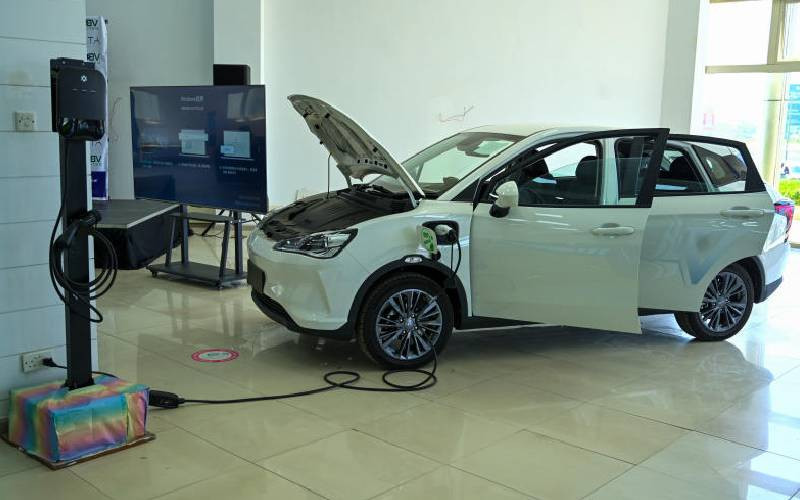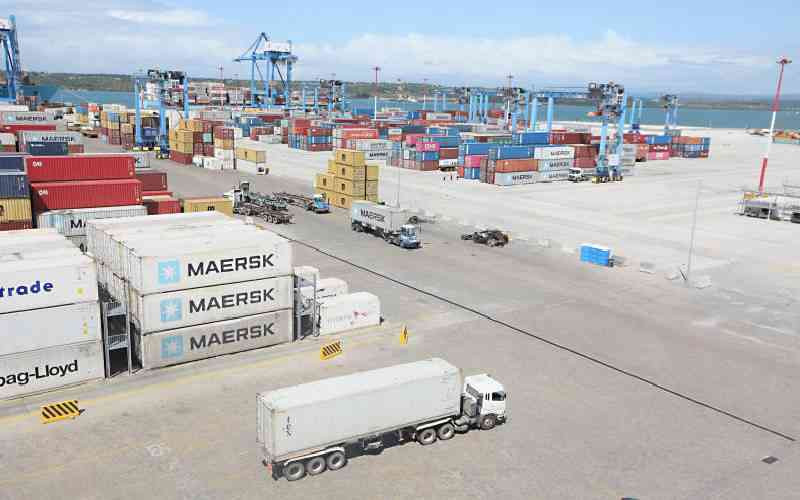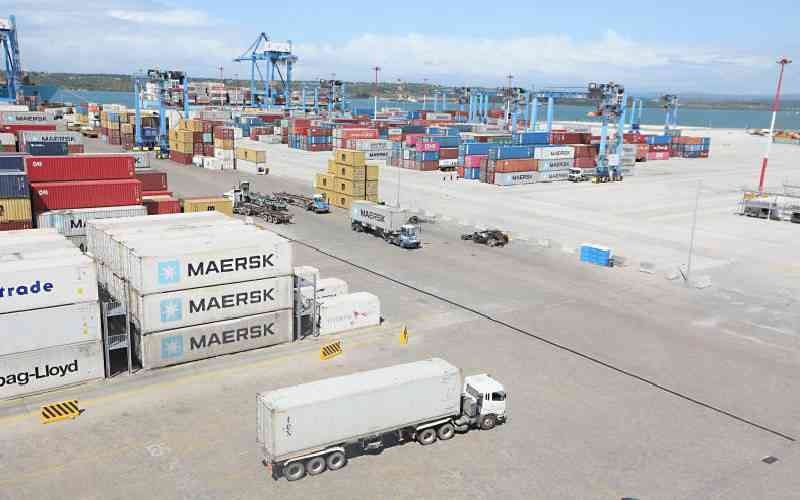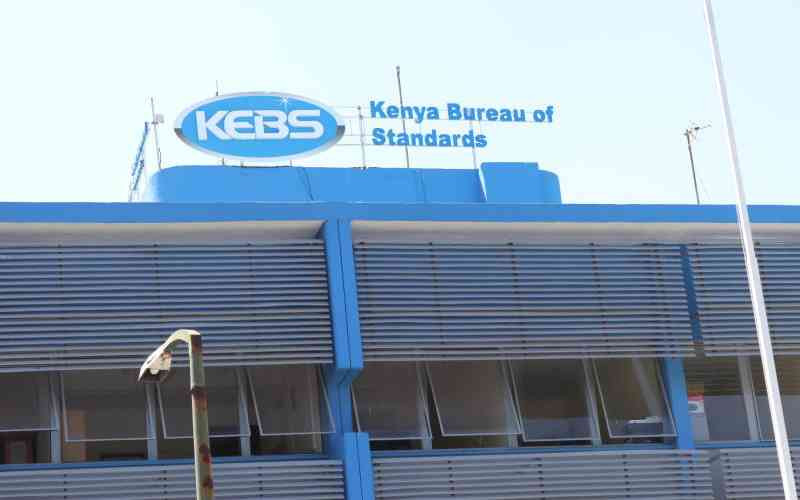
The 100 per cent NETA V electric vehicle being showcased by MOJA EV Kenya Limited at Sameer Business Park in Nairobi, on May 31, 2024. [Robert Tomno, Standard]
Kenya‘s electric vehicle (EV) revolution is picking up speed, driven by homegrown innovation, government incentives, and growing demand for cleaner, cost-efficient transport.
A recent landmark 1,600 km cross-border ride by Roam Air, Kenya’s flagship electric motorcycle, from Nairobi to Addis Ababa, Ethiopia, has symbolized this transition, showing that Africa’s electric mobility future is not only viable but already unfolding on the continent‘s road.
The journey—dubbed „The Road to Addis“ was completed in six days and ended in time for the Africa E-Mobility Week (October 14–16). It demonstrated the Roam Air’s endurance, 160 km dual-battery range, and ability to charge from standard power outlets, even in remote towns without formal EV infrastructure.
“This ride proved that African innovation is not waiting for the future, it’s already happening,” said Habib Lukaya, Country Manager at Roam. “The Roam Air has once again shown it can handle the heat, dust, and distance of our continent, powered purely by clean energy.”
The symbolic ride comes at a time when Kenya is experiencing a surge in EV adoption.
According to the National Transport and Safety Authority (NTSA), the country had registered over 9,000 EVs by May 2025, nearly doubling the number, from 4000 in 2023. The government aims for EVs to make up five per cent of all new vehicle registrations by the end of 2025.
The EV market in Kenya is dominated by electric motorcycles, which make up about 90 per cent of registrations, but there is a growing number of electric cars.
Lukaya says Kenya’s EV sector has grown rapidly in the last three years.
“Kenya is clearly shifting from pilot stage to commercial scale, driven by local manufacturing, better financing, and supportive energy policies,” Lukaya .
The growth is evident, as shown by the recent data by Kenya Power showing that electricity use under the e-mobility tariff jumped from 1.26 GWh to over 5 GWh, marking a 300 per cent rise. Two- and three-wheeler vehicles dominate, accounting for nearly 90 per cent of all EVs, with around 300 charging points now available countrywide.
Lukaya observed that EVs steadily adoption especially among two-wheelers (boda boda) riders and businesses has been fuelled by its saving nature on fuel and low maintenance.
“Private car adoption is slower due to higher prices, but interest is growing as awareness and options expand. A Roam Air rider saves up to 35 per cent during loan repayment and up to 80 per cent after, compared to petrol bikes,” he said as he emphasised on cost efficiency.
Maintenance costs
Stay informed. Subscribe to our newsletter
For commercial viability, he says, Matatu drivers have shown a reduced fuel and maintenance costs, while urban taxis benefit from predictable daily mileage and overnight charging.
“For motorcycles, it’s already proven; riders can charge anywhere there’s power, making the model simple and scalable. Additionally, they have Roam Hub networks to charge and rent batteries to avoid downtime”.
Also, the government incentives, expanding charging infrastructure, and lower running costs have been identified as key factors driving EVs uptake growth.
The Chinese automobile manufacturer, Loxea Kenya, a subsidiary of CFAO Mobility Kenya said the sale success of electric vehicles in Kenya is steadily growing and a total shift is clearly in the picture.
According to Jennifer Kinyoe, Loxea‘s Kenya Managing Director, Plug-in hybrid electric vehicles (PHEV), are proving to be a popular customer choice.
“BYD vehicles are proving to be very popular models among discerning local clients in Kenya and beyond, seeking quality mobility solutions,” Kinyoe said.
According to George Githinji, the chairman Oma services Ltd, the electric mobility space has seen excellent performance, both in revenue and customer’s positive change of attitude toward it.
“People are moving towards electric mobility due to cost efficiency, such as maintenance costs and customers demand for environmentally friendly e-buses,” Githinji said.
Charging stations
For electric mobility, Githinji notes that, it is commercially viable, especially on lease models for short term gains and cash basis for long-term gains.
However, just like any industry, the EV experts said the industry has been facing some challenges such as low power supply and policy gaps.
“Sometimes there is high demand of EVs but the supply is low. Charging stations are also few, coupled up with unreliable power supply and lack of approvals for new facilities,” he said.
While noting that this is the future of mobility, he reckons that it presents a worrying environment for fuel driven locomotives.
“Fuel driven mobility may see a dwindling business and loss of revenue,” Githinji said, adding that electric vehicles space holds high investment stake at the moment.
Lukaya noted that the increase of EVs signals reduced long term fuel demand and changing service models, fewer oil changes, more battery and electronic work. And with major hailing companies targeting full electrification by 2040, he projects that fuel powered fleets will eventually phase out in public transport.
Lukaya further predicts that in the next three to seven years, two-wheelers, taxis, and delivery fleets will lead the growth of electric vehicles, followed by matatus and buses as financing improves.
“Kenya will move toward a mixed fleet, but battery ownership, not swapping, will define the next phase of EV freedom and value,” Lukaya said.
While the demand for electric mobility continues to rise, particularly among delivery firms, access to financing has remained a major barrier, limiting many businesses to cash purchases and preventing scale.
According to ROAM, there is need to remove financing bottlenecks to accelerates Kenya’s shift to clean and cost-efficient mobility.
Lukaya pointed out that the conventional loans do not fit EV lifecycles as lenders struggle with asset valuation and repayment models. Further, tailored financing for riders, is a model that can be scaled to fleets and larger vehicles to drive mass adoption.
In July 2025, the mobility company, together with Fortune Credit tailored-made an electric motorcycle financing model to match the real income flows of small business owners and informal sector riders.
“The first-ever electric motorcycle financing program is aimed at unlocking access to electric motorcycles for both individuals and businesses. This partnership is about breaking systemic barriers. By offering a locally made, zero-emission motorcycle with a flexible ownership model, we’re enabling more riders and businesses to switch to electric, save money, and create jobs,” Lukaya noted.







